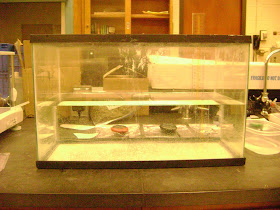Week 1
Most of week 1 was spent dissecting turtle embryos. The eggs, for the most part, had reached the temperature-sensitive period (TSP). Embryos were removed from the eggs and the brain, gonadal, and adrenal/kidney tissues were collected. These tissues were stored in a sodium/phosphate buffer and placed in the freezer at -80 degrees celsius.
Week 2
Week 2 was comprised of a variety of activities, all focused on determining the interactions between DAX1 and SF1.
Like the previous week, a great deal of time was spent on collecting the necessary tissues.
Eggs were dissected and the brain, gonadal, and kidney/adrenal tissues were stored in sodium phosphate buffer at -80 celsius.
In addition, a nuclear fraction was extracted from a stored sample of brain tissue. This fraction was split into multiple aliquots, which were to be incubated and used in an isoelectric focusing (IEF) gel (since the fraction presumably contained both DAX1 and SF1).
Samples were incubated at 26, 31, and 0 degrees celsius. After 30 minutes, a formaldehyde solution was added to fix any protein-protein interactions that had taken place. Incubation continued for an additional 15 minutes, before a solution of 1.25 M glycine, pH 7.5, was added to stop the fixation process.
The IEF gel was loaded with the samples and run according to the gel electrophoresis recommendations. Proteins were transferred to a nitrocellulose membrane using acetic acid transfer and developed using the western blotting technique. Unfortunately, the results were not satisfying.
Only the IEF markers and the positive control (isolated SF1) appeared on the developed membrane. We were not sure why the others samples did not appear, but we did have a couple of predictions. First of all, we had never preformed an acetic acid transfer. The procedure was new to us and there were a number of things that could have gone wrong. Secondly, none of the samples treated with formaldehyde appeared. We had seen a white slurry form on top of the formaldehyde containing samples before loading, which we believed may have interfered. Our initial conclusion was that a salt had formed between the sodium phosphate buffer in the formaldehyde and the elution buffer in the nuclear extract.
To resolve our conflict we decided to test the transfer technique and make a new solution of formaldehyde. An agarose gel was made up this time and loaded with samples following the same conditions as before. The only difference was that the formaldehyde was made up in a tris-HCl buffer instead of sodium phosphate. The gel was run and transferred to nitrocellulose again, but the transfer conditions were altered. This time we decided to use the wicking method. We cut the gel in half, placed one half in acetic acid buffer, and placed the other half in saline-sodium citrate buffer (SSC).




































 English ivy
English ivy Jewel weed
Jewel weed




